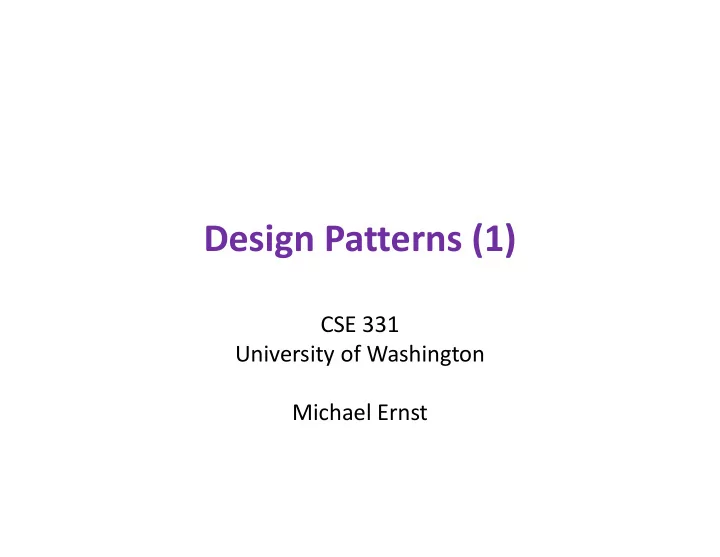

Design Patterns (1) CSE 331 University of Washington Michael Ernst
Outline � Introduction to design patterns � Creational patterns (constructing objects) � Structural patterns (controlling heap layout) � Behavioral patterns (affecting object semantics)
What is a design pattern? • A standard solution to a common programming problem – a design or implementation structure that achieves a particular purpose – a high-level programming idiom • A technique for making code more flexible – reduce coupling among program components • Shorthand for describing program design – a description of connections among program components – the shape of a heap snapshot or object model
Example 1: Encapsulation (data hiding) � Problem: Exposed fields can be directly manipulated � Violations of the representation invariant � Dependences prevent changing the implementation � Solution: Hide some components � Permit only stylized access to the object � Disadvantages: � Interface may not (efficiently) provide all desired operations � Indirection may reduce performance
Example 2: Subclassing (inheritance) � Problem: Repetition in implementations � Similar abstractions have similar members (fields, methods) � Solution: Inherit default members from a superclass � Select an implementation via run-time dispatching � Disadvantages: � Code for a class is spread out, and thus less understandable � Run-time dispatching introduces overhead
Example 3: Iteration � Problem: To access all members of a collection, must perform a specialized traversal for each data structure � Introduces undesirable dependences � Does not generalize to other collections � Solution: � The implementation performs traversals, does bookkeeping � The implementation has knowledge about the representation � Results are communicated to clients via a standard interface � Disadvantages: � Iteration order is fixed by the implementation and not under the control of the client
Example 4: Exceptions � Problem: � Errors in one part of the code should be handled elsewhere. � Code should not be cluttered with error-handling code. � Return values should not be preempted by error codes. � Solution: Language structures for throwing and catching exceptions � Disadvantages: � Code may still be cluttered. � It may be hard to know where an exception will be handled. � Use of exceptions for normal control flow may be confusing and inefficient.
Example 5: Generics � Problem: � Well-designed data structures hold one type of object � Solution: � Programming language checks for errors in contents � ���������� instead of just ���� � Disadvantages: � More verbose types
When (not) to use design patterns � Rule 1: delay � Get something basic working first � Improve it once you understand it � Design patterns can increase or decrease understandability � Add indirection, increase code size � Improve modularity, separate concerns, ease description � If your design or implementation has a problem, consider design patterns that address that problem � Canonical reference: the "Gang of Four" book � Design Patterns: Elements of Reusable Object-Oriented Software , by Erich Gamma, Richard Helm, Ralph Johnson, and John Vlissides, Addison-Wesley, 1995. � Another good reference for Java � Effective Java: Programming Language Guide , by Joshua Bloch, Addison-Wesley, 2001.
Why should you care? � You could come up with these solutions on your own � You shouldn't have to! � A design pattern is a known solution to a known problem
Creational patterns � Constructors in Java are inflexible 1. Can't return a subtype of the class they belong to 2. Always return a fresh new object, never re-use one � Factories � Factory method � Factory object � Prototype � Dependency injection � Sharing � Singleton � Interning � Flyweight
Factories � Problem: client desires control over object creation � Factory method � Hides decisions about object creation � Implementation: put code in methods in client � Factory object � Bundles factory methods for a family of types � Implementation: put code in a separate object � Prototype � Every object is a factory, can create more objects like itself � Implementation: put code in ����� methods
Motivation for factories: Changing implementations � Supertypes support multiple implementations ���������������� ������� ������������������ ������������������������� ����������������� ������������������������� � Clients use the supertype ( ������ ) � Still need to use a ������������ or ����������� constructor � Switching implementations requires code changes
Use of factories � Factory ������������������� � �������������������������������������� ������������������������� � � � Clients call ������������ , not a particular constructor � Advantages � To switch the implementation, only change one place � Can decide what type of matrix to create
Example: bicycle race ������!����� ""������������#�$ !����������!����������� %���������&�'�(�����%�������� ���� %���������&�)�(�����%�������� ���� ��� � �
Example: Tour de France ������*����������� �����$� !����� ""������������#�$ !����������!������� %���������&�'�(�����!��$%�������� %���������&�)�(�����!��$%�������� ��� � �
Example: Cyclocross ������+��������� �����$� !����� ""������������#�$ !����������!������� %���������&�'�(�������������%�������� %���������&�)�(�������������%�������� ��� � �
Factory method for Bicycle ������!����� %�������������%���������������� !����������!������� %���������&�'�(�������%�������� %���������&�)�(�������%�������� ��� � �
Code using factory methods ������!����� %�������������%���������������� !����������!������� %���������&�'�(�������%�������� %���������&�)�(�������%�������� ��� � � ������*����������� �����$��!����� %�������������%���������� �����������!��$%�������� � � ������+��������� �����$��!����� %�������������%��������������� �������������������%�������� � �
Factory objects/classes encapsulate factory methods ������%������������� � %�������������%���������������� ��������������������������� ,#����������,#������������� ��� � ������!��$%������������� �����$��%������������� � %�������������%���������� �����������!��$%�������� � � ��������������%������������� �����$��%������������� � %�������������%���������� �������������������%�������� � �
Recommend
More recommend